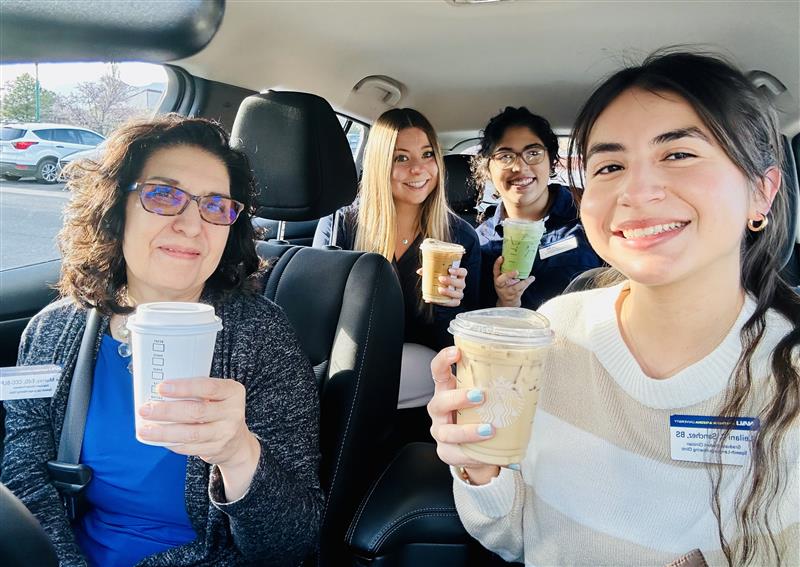The classroom for a group of communication sciences and disorders students doesn’t have four walls. Class doesn’t start at 8 a.m., and the assignments aren’t questions to be answered.
These graduate students join NAU professor Fe Murray frequently throughout each semester to travel to rural areas in northern Arizona that need a multilingual speech evaluation. It’s a valuable partnership; the students, who are preparing to become speech-language pathologists (SLP), get hands-on experience working with students, and communities and school districts get access to top-notch evaluation services at no cost.
NAU’s Multilingual Evaluation Team is especially critical in Arizona, where an estimated 25% of children speak a language other than English at home. Historically, a language difference can complicate diagnosing actual speech disorders, and an SLP who speaks only English may not recognize the signs, Murray has found in previous research.
“As our country’s, and our state’s, demographics continue to evolve, with a growing number of languages spoken, it’s crucial for speech-language pathology services to be inclusive and accessible to all communities,” said Murray, whose team of graduate-level SLP students “strive to bridge the gap between the linguistic diversity in our society and the stagnant representation of multilingual SLPs in the field.”
The team’s process intends to promote evidence-based and culturally linguistic appropriate evaluations, diagnosis and treatment, and it is truly a team effort. Each member of the Multilingual Evaluation Team has a task tailored to their individual skillset. Those fluent in only English may conduct assessments, interview the caregivers and document nonverbal cues during assessments. Bilingual SLP students often oversee similar tasks but vary on an individual level. Regardless of any one skillset, Murray said, all team members are tasked with critically analyzing data and composing detailed reports with recommendations.
The team is most needed when a school’s resident SLP isn’t fluent in the native language of one or more of the students, hence their recent 6:30 a.m. start to travel an hour to a rural school district.
On this day, the district contacted the evaluation team to assess a student who had recently moved to northern Arizona from a Spanish-speaking country. They were tasked with completing a comprehensive evaluation of his communication skills in both English and his native language as the district did not have the resources to do so. Upon arrival, each went about their assigned tasks to complete the comprehensive assessment.
Since its inception in 2015, the Multilingual Evaluation Team has helped more than 90 individuals in rural areas—mostly PreK-12 students, but a few adults and toddlers as well—and helped train 60 graduate students before they enter their chosen field. Students get to work with individuals who represent every dimension of the SLP experience, interviewing parents and faculty, collaborating with monolingual SLPs, working with teachers of the deaf and hard of hearing and consulting with audiologists. The multilingual evaluation team not only provides a detailed assessment of students’ language skills but also gives the participating students a glimpse into life as an SLP.
DYK? Most of their evaluations are in Spanish, but the Multilingual Evaluation Team has also worked with individuals who speak Korean, Mandarin Chinese, Polish, Navajo, Thai, Russian, Ukrainian and Farsi.
Murray started the program as a means to leverage her experience and knowledge as a bilingual SLP and provide essential clinical experiences for a growing number of bilingual graduate students. The service began very small, but grew as the years went on and demand increased. Depending on schedule alignments, the team now receives five to eight evaluation requests a semester.
“Being part of this multilingual evaluation team has allowed me to have a greater impact than I would have had as a singular practitioner,” Murray said. “It is imperative that our institution graduates future SLPs capable of delivering culturally competent care, thereby bridging prevailing educational and healthcare disparities stemming from cultural and linguistic differences between students, patients and the SLPs serving them.”
How the community benefits
One other element of the Multilingual Evaluation Team is the assistance they provide to SLPs who request their services. Murray said on-site school SLPs often observe the team’s planning and evaluation processes and implement similar strategies and tools in their assessments, meaning students will continue benefiting years from now.
It also provides answers where previously there hadn’t been many. Educators and families often overlook speech-language pathology when searching for help for kids who are struggling, and they sometimes mistake children’s speech difficulties for other disorders. That’s why SLPs can play such a critical role.
Murray is committed to continuing to provide evaluation services to her community alongside other faculty members. She also hopes to expand training opportunities to include summertime students and students based in Yuma.



